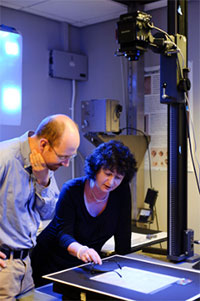
The travels of David Livingstone, the celebrated doctor, missionary, and explorer of Africa, are “officially” documented in The Last Journals of David Livingstone (1874), published after the explorer's death in 1873.
But, Adrian Wisnicki, assistant professor of English at IUP, recently led an international team of experts in recovering the text of one of Livingstone's most important, uncensored original diaries. The project showcases the power of spectral-imaging technology as a tool for cultural heritage studies.
Team members will give an insider's view of their work February 29, 2012, at 5:30 p.m. in the IUP Libraries' Serials Department, on the building's ground floor.
The presentation—the team's first in the United States on the Livingstone project—will be free and open to the community. The initial publication of the recovered diary late last year drew worldwide attention.
Participating in panel discussion, titled “The Livingstone Spectral Imaging Project: Behind the Scenes,” will be Wisnicki; Mike Toth, R.B. Toth Associates; Roger L. Easton Jr., imaging scientist, Rochester Institute of Technology; and A.J. Schmitz, research assistant and IUP doctoral student.
In conjunction with the February 29 program, Easton will give a presentation, “Reading between the Lines: 10 Years of Imaging of the Archimedes Palimpsest,” March 1 at noon, also in the IUP Libraries.
In addition to his work on the Livingstone diary, Easton is part of an imaging team that has helped scholars read the original text in the Archimedes Palimpsest, a 10th-century manuscript containing the oldest copies of seven of Archimedes' treatises.
In 2009, Wisnicki, who specializes in British literature, found pages from Livingstone's original diary in an unmarked box in an archive in Scotland and then worked with a team of scholars, scientists, and archivists from around the world to make the entries legible. Many were written with makeshift ink and on old newspapers.
“It's been an extremely exciting project, not only because of what we have learned about Livingstone, but because of how technology and science have helped us to make this discovery,” Wisnicki said.
“Projects like this show the importance of centers like IUP's Digital Humanities Center, which has been created to support projects at IUP like the Livingstone project, recognizing that technology is part of academic work across all disciplines.”
Wisnicki is co-director of the Center for Digital Humanities and Culture, which, he said, works to facilitate conversation, collaboration and resource sharing among specialists within the disciplines at IUP, while making connections among experts around the world and between new technologies and traditional knowledge areas. “This project demonstrates the remarkable results possible when experts from different fields come together.”
The Digital Humanities Center is preparing to launch a fund drive to support its future activities.